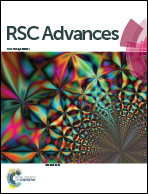Nano graphene oxide–hyaluronic acid conjugate for target specific cancer drug delivery†
Abstract
A nano graphene oxide–hyaluronic acid (NGO–HA) conjugate was successfully prepared for target specific delivery of an anti-cancer drug loaded by π–π stacking via HA receptor mediated endocytosis. In vitro tests confirmed the pH dependent drug release and target specific anti-cancer effect of the complex.


 Please wait while we load your content...
Please wait while we load your content...